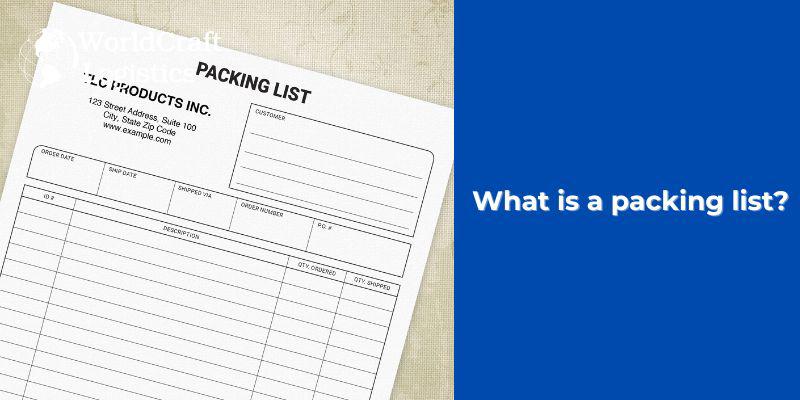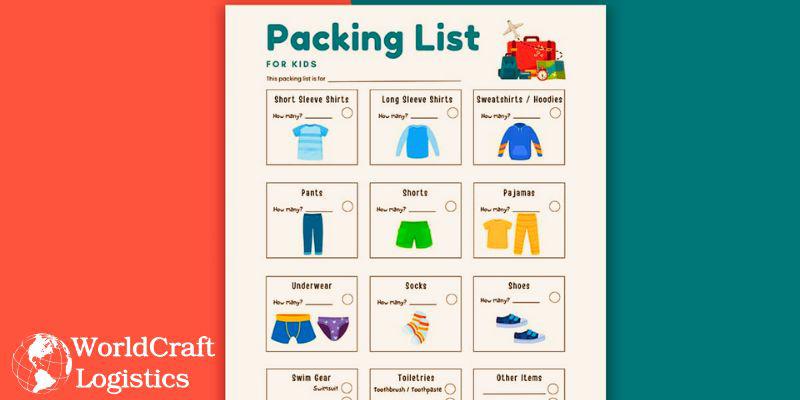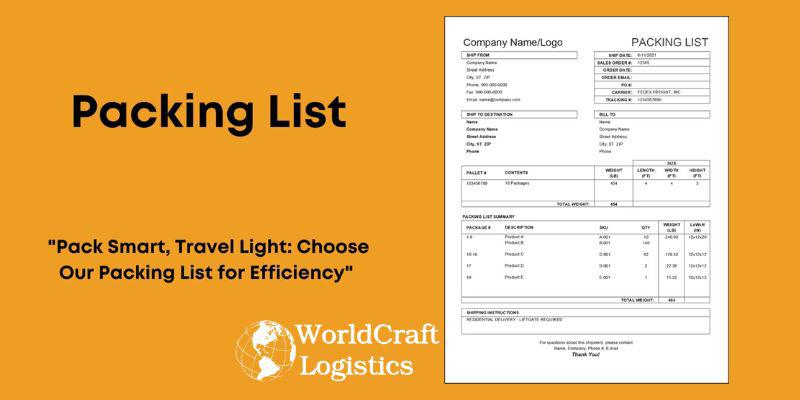
Starting June 1st, 2023 Our warehouse fee will be $0.65/cubic foot per month
In effort to lower the warehouse storage fee during inflation, we have went narrow aisle racking.This construction took us four months but the project is finally completed. With narrow aisle racking, we are able to drop storage by 24%.We as partners will go through this inflation together.
05/21/2024
In logistics, the packing list is a fundamental document accompanying the delivery of goods. It provides clear and concise information on the products in the delivery, their quantities, and other relevant specifications. Its importance lies in its role in facilitating efficient and error-free logistics processes, ensuring both carriers and consignees receive and handle cargo correctly.

A packing list is a crucial document in international trade. It supplies the exporter, international freight forwarder, and final consignee with essential details about the shipment. This includes information on how the items are packed, the dimensions and weight of each package, and the identifying marks and numbers displayed on the boxes.
Packing list formats differ significantly based on the unique needs and preferences of each company or industry. Some opt for predesigned templates in word processing or spreadsheet software, while others create their own. Below are common packing list formats:
📦 Pre-made templates: Numerous ready-to-use templates are available online for free or via subscription. These customizable templates often include predefined fields for product name, quantity, description, and weight.
📦 Customized formats: Some companies develop tailored packing list formats to meet specific needs. These may feature optional or customized fields according to company or customer requirements, such as serial numbers, barcodes, special instructions, or other delivery-related information.
📦 Digital formats: With advancing technology, more companies are adopting digital packing lists over paper documents. Digital formats may include PDFs, spreadsheets, or warehouse management systems (WMS) that facilitate digital creation and management. These formats offer easy editing and sharing, reduced paper use, and integration with other business systems.
Regardless of the chosen format, it is crucial that all necessary information is presented clearly and understandably. Ensuring the formats meet customer and business partner requirements helps facilitate information exchange and ensures efficient logistics.

Read more:
👉 Purchase Orders: Meaning, Types & What To Note
👉 Single Entry Bond and Continuous Bond: Meaning, the Differences
👉 Customs Bonds: The value of US Import Bonds & Why important
The significance of the packing list in logistics is essential for several reasons:
🔎 Facilitates shipment identification and verification: The packing list provides a detailed account of the products in the shipment, simplifying the identification and verification process for shippers and receivers. This is crucial in logistics, where handling large volumes of goods and ensuring delivery accuracy are vital.
🔎 Enhances warehousing and distribution efficiency: With detailed product and quantity descriptions, the packing list helps streamline warehousing and distribution. Warehouse staff can use this information to organize products efficiently and prepare shipments accurately.
🔎 Simplifies inventory management: Serving as a comprehensive description of shipped products, the packing list aids in inventory management for both carriers and recipients. It enables precise inventory tracking and helps identify discrepancies between delivered and received items.
🔎 Minimizes errors and losses: The packing list reduces the risk of errors and losses during shipment and pickup by offering complete and accurate documentation of the shipment's contents. This contributes to more efficient and stable operations, increasing transparency and control throughout the logistics process.

Your export packing list must detail the number of units, boxes, and all available packaging information, ensuring these details match the Commercial Invoice and reflect the same transaction parties.
Packing lists should note if solid wood was used for packing, along with a fumigation or heat treatment certificate if necessary.
When drafting a packing list, include extensive details about the shipment, such as:
Date
Shipper and exporter contact information
Consignee contact information
Origin address of cargo
Destination address of cargo
Total number of packages
Detailed description of each package
Volume and weight of each package
Volume and weight of the entire shipment
Commercial invoice number for this shipment
For shipments with fragile items requiring specialized handling, visit our page on Secure and Specialized Fragile Shipping for best practices and advice to ensure safe delivery of delicate goods.

Creating a packing list involves meticulous attention to detail and a structured approach to ensure precision and efficiency.
Begin by collecting all required details about the products to be shipped, including names, quantities, sizes, and weights.
Opt for a packing list format that fits your needs, whether a pre-designed template or a customized version with specific fields for your company or customers.
Clearly indicate the quantity of each product in the shipment. Accurate descriptions are crucial to prevent confusion during delivery and receipt.
Before finalizing, review all entered information to ensure accuracy and consistency. Correct any errors or inconsistencies and align the documentation with company procedures.
📌 Use clear and concise language: Avoid vague terms in product descriptions. Ensure information is easily understood by both the sender and recipient, clearly explaining the packed items.
📌 Organize information logically: Structure the packing list so the information is well-organized and easy to follow. Group products by category or type for easy browsing and editing.
📌 Include special instructions or requirements: If there are special instructions or requirements for shipping or receiving the product, include them on the packing slip. This may involve handling fragile items, storing at certain temperatures, or other important details.
📌 Ensure information is complete and up-to-date: Before shipping, verify that the packing list contains all necessary information and is current. Enter the correct quantity for each product and finalize the shipping details.
📌 Use barcodes or identification systems: If possible, use barcodes or other identification systems to facilitate tracking and product identification during logistics. This speeds up processing and reduces errors.
📌 Keep a copy of the packing list for your records: This can be useful if there are delivery deviations or complaints.
By following these steps, you can create efficient and accurate packing lists that simplify logistics and ensure successful product delivery.
Need help? Contact our experts to ensure you don’t miss any important documents in the import process.
SEO
Digital Marketing/SEO Specialist
Simon Mang is an SEO and Digital Marketing expert at Wordcraft Logistics. With many years of experience in the field of digital marketing, he has shaped and built strategies to effectively promote Wordcraft Logistics' online presence. With a deep understanding of the logistics industry, I have shared more than 500 specialized articles on many different topics.

Education
01/05/2025

Education
02/18/2025

Education
01/01/2024

Education
08/28/2024

Education
11/13/2023